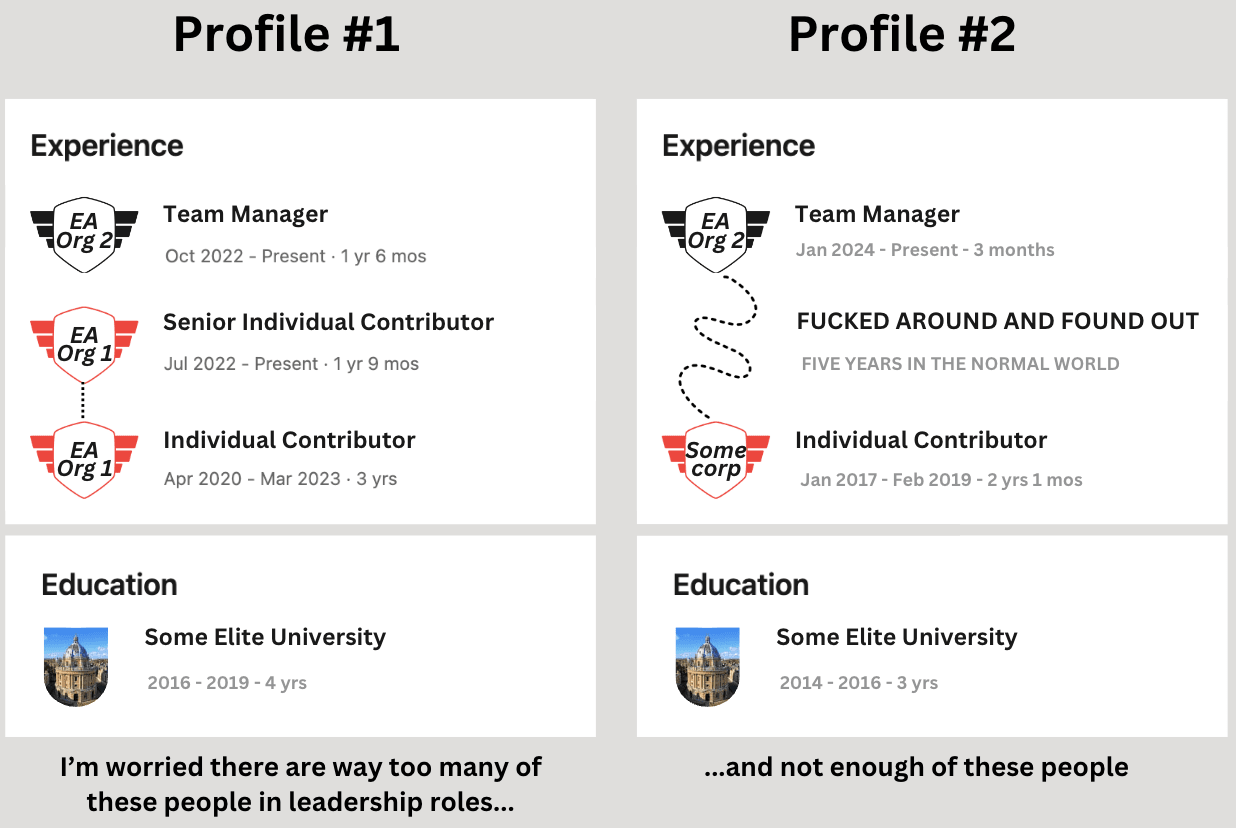The following story is fictional and does not depict any actual person or event...da da.
(You better believe this is a draft amnesty thingi).
Epistemic status: very low confidence, but niggling worry. Would LOVE for people to tell me this isn't something to worry about.
- - - - -
I've been around EA for about six years, and every now and then I have an old sneaky peak at the old LinkedIn profile.
Something I've noticed is that there seems to be a lot of people in leadership positions whose LinkedIn looks a lot like Profile #1 and not a lot who look like Profile #2. Allow me to spell out some of the important distinctions:
Profile #1:
- Immediately jumped into the EA ecosystem as an individual contributor
- Worked their way up through the ranks through good old fashioned hard work
- Has approximately zero experience in the non-EA workforce and definitely non managing non-EAs. Now they manage people
Profile #2:
- Like Profile #1, went to a prestigious uni, maybe did post grad, doesn't matter, not the major point of this post
- Got some grad gig in Mega Large Corporation and got exposure to normal people, probably crushed by the bureaucracy and politics at some point
- Most importantly, Fucked Around And Found Out (FAAFO) for the next five years. Did lots of different things across multiple industries. Gained a bunch of skills in the commercial world. Had their heart broken. Was not fossilized by EA norms. But NOW THEY'RE BACK BAYBEEE....
- - - - - -
If I had more time and energy I'd probably make some more evidenced claims about Meta issues, and how things like SBF, sexual misconduct cases or Nonlinear could have been helped with more of #2 than #1 but don't have the time or energy (I'm also less sure about this claim).
I also expect people in group 1 to downvote this and people in group 2 to upvote it, but most importantly, I want feedback on whether people think this is a thing, and if it is a thing, is it bad.


This doesn't really match my (relatively little) experience. I think it might be because we disagree on what counts as "EA Leadership": we probably have a different idea of what counts as "EA" and/or we have a different idea of what counts as "Leadership".
I think you might be considering as "EA leadership" senior people working in "meta-EA" orgs (e.g. CEA) and "only-EA experience" to also include people doing more direct work (e.g. GiveWell). So the CEO of OpenPhilanthropy would count as profile #1 having mostly previous experience at OpenPhilanthropy and GiveWell, but the CEO of GiveWell wouldn't count as profile #2 because they're not in an "EA leadership position". Is that correct?
I think the easiest way would be to compile a list of people in leadership positions and check their LinkedIn profiles.
Working on the assumption above for what you mean by "EA Leadership", while there is no canonical list of “meta-EA leaders”, a non-random sample could be this public list of some Meta Coordination Forum participants.[1]
Here's a quick (and inaccurate) short summary of what they show on LinkedIn before their roles:[2]
Edit: this is getting a lot of votes, I want to really highlight that this is not how I would compile a list of "EA Leadership".[3]
Climate Science Advisor for the Office of the President of the Maldives, (in parallel) 4 years PhD in atmospheric, oceanic and planetary physics, 2 years Executive Director at a climate change policy analysis group
I think that even in this highly biased sample there are plenty of examples of Profile #2, a quick count is 50%. Did you have a different reference class in mind?
Note that this is a list of people who:
1. Were invited and planned to attend a top "meta meta-EA" event.
2. Decided to have their name public (12 people out of 43 did not disclose their intention to attend)
I think this skews heavily in favour of #1, people less professionally close to EA are probably more likely to opt-out, and to not care as much about "meta meta" things even if they were invited.
Also note, from the original post:
This was compiled very quickly, there will be errors. Apologies to the people mentioned, this is only meant to be a quick overview.
Also note that different people spend very different amounts of time polishing their LinkedIn profile, things are self-reported and not verified, and some might not mention their "real world" experiences or some "EA" experiences.
E.g. I would include senior people at GiveWell's top charities (where most of the money goes) and at GiveWell itself
Just to be clear, my conception of Type 2 is that they're still involved in EA (e.g. through ETG, volunteering, meetups), but their job isn't, for some period of time.
Which is partly why I think 25%/75% is better than 50/50